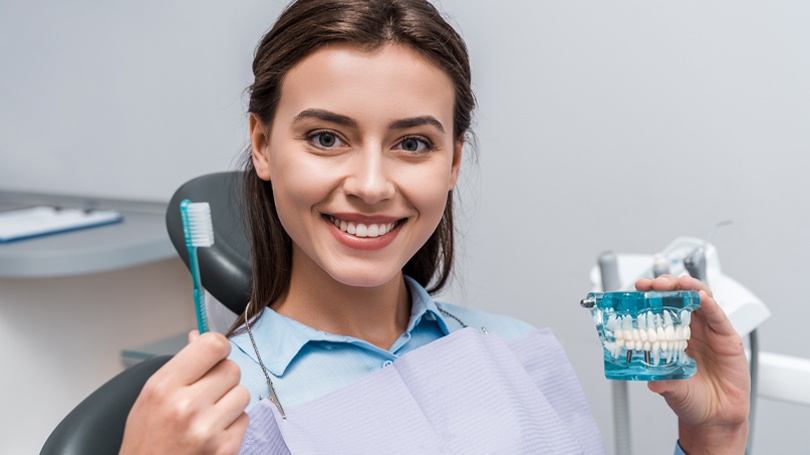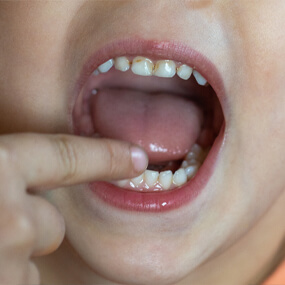What Is Subgingival Calculus and How Do You Prevent It?

Plaque begins to form in your mouth whenever you eat, which is why diligent oral care is so important to oral health. Lacking good oral hygiene, plaque will not only build up but calcify into dental calculus, which is often called tartar. Calculus can be either supragingival—above the gumline—or subgingival—below the gumline. Subgingival calculus can result in gum disease and eventually tooth loss.
The Process of Calculus Formation
Plaque is a sticky film that adheres to your teeth and other surfaces in your mouth. When it calcifies, it bonds to those surfaces, not unlike how barnacles bond to boat hulls. Plaque can be removed by brushing and flossing, but tartar must be scraped away by a dental professional.
Plaque forms as bacteria interacts with food particles and your saliva. That plaque can accumulate anywhere in the mouth where it has access to nutrients, and bacteria on a shared surface form communities known as biofilm. That biofilm collects calcium, phosphorous and other minerals in the mouth, which is what causes the film to harden and to develop a much stronger adhesive bond.
The Qualities of Subgingival Calculus
As mentioned in the introduction, calculus can form above the gumline—supragingival—or below it—subgingival. The difference is its position relative to the gumline. While supragingival calculus tends to be yellowish or whitish in color, subgingival calculus tends to be dark brown and even green or black. Subgingival calculus not only affects your gums but aspects of your mouth below the gums. This includes the cementum, which is weaker than even dentin, but also connective tissues and bone.
Often, patients are not even aware of subgingival calculus, and their dentists have to detect it using a dental explorer. Once found, your dentist will recommend cleaning it, which requires scraping using specialized dental tools. Your dentist will numb the tooth roots and gums to avoid any discomfort.
Subgingival Calculus and Periodontal Disease
Plaque causes periodontal disease, and this can occur before plaque has hardened into dental calculus. The earliest stage of gum disease is gingivitis. Gingivitis can be rather silent in terms of symptoms, and when it does manifest symptoms, those include redness, swelling, and minor bleeding. Gingivitis is reversible, and caught early enough, improved oral care at home may be the only treatment needed.
Gingivitis will eventually progress to a more advanced stage of gum disease known as periodontitis. This generally happens because plaque has spread below the gumline, and tartar often helps this growth. Gums can recede prior to periodontitis but become a common symptom at this point. The Mayo Clinic notes that pockets deeper than 4 millimeters are an indication of more advanced gum disease.
Plaque continues to accumulate in these pockets and harden into tartar. This allows the bacteria to attack not just the gum tissue but connective tissue and the supporting bone structures. Periodontitis usually requires your dentist to perform scaling and root planing. In some cases, oral surgery may be necessary in order to treat gum loss or bone loss that has occurred.
Stopping Plaque From Hardening
Plaque occurs before calculus, so the focus should be on removing and disturbing plaque on a daily basis. Do that, as well as regularly visit with your dentist, and tartar will never be a problem. You should brush twice a day for two to three minutes at a time using a soft-bristled brush and fluoride toothpaste. Whenever you brush, floss and either scrape or brush your tongue. You may want to discuss an antimicrobial mouthwash with your dentist in order to determine which products are best for you and how often he or she recommends using them. Finally, biannual dental cleanings are imperative in order to clean any plaque or tartar you missed, and most people will miss some over half a year.
Prevent Subgingival Calculus From Building Up
The formation and accumulation of plaque is a fact of oral health that you will need to monitor throughout your life. That does not have to be difficult, however. Success lies in good oral hygiene at home, regular cleanings by the oral hygienists at Scottsdale Cosmetic Dentistry Excellence, and regular exams and treatments by Jeffrey D. Clark, DDS. If you have put off seeing a dentist for a while, then you may have a plaque problem and even subgingival calculus. Call 480 585 1853 today to schedule a cleaning.




